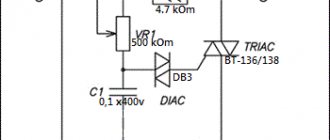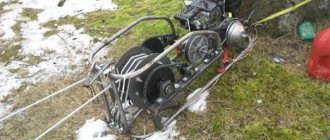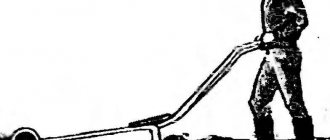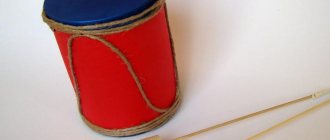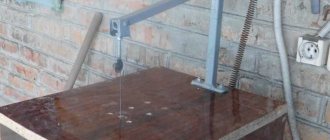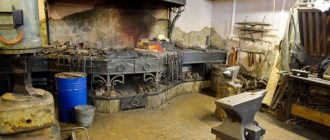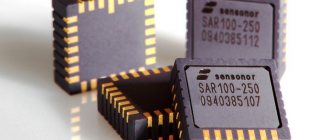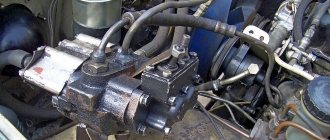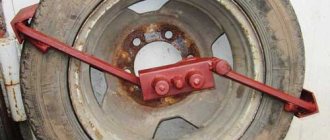The proposed homemade plow-electric winch (see illustration) has a number of additional advantages associated with the relative cheapness of electricity, ease of acquisition and long life (over 30 years) of trouble-free operation of the electric motor, ease of start-up and operation of the entire structure. The gearbox speed control lever is located in close proximity to the unit with electrical equipment (capacitors, magnetic starter, “Start” and “Stop” buttons). Next to it is a coil of cable on a reel.
So the electric winch can be anchored anywhere on the land plot at a distance of up to 100 m from its connection to the power grid (with a longer cable length, line losses increase). And the built-in remote control with a “Stop” button allows you to control and plow, even working together with a disabled person. When a boulder or tree roots get under the plow , the force on the rope increases sharply.
And when it becomes the maximum permissible (330 kgf), the winch electric motor stops, preventing the rope from breaking (as well as breaking the chain transmission mechanism). And one more feature. Thanks to the modular design, if necessary, you can easily remove the engine and the unit with electrical equipment from the electric winch (it is enough to unscrew 4 M10 bolts) and, installing them on an electric sawing machine, start preparing firewood, slats, timber, etc. By rearranging these same block units onto the grass cutter, we obtain valuable, vitamin-rich feed for livestock and poultry.
Well, having replaced the plow with a towed cultivator-hiller, the same electric winch can be used not only for weeding and hilling, processing row spacing, but also, say, for digging potatoes. Kinematics? The proposed home-made design is so elementary (and therefore reliable) that it is unlikely to cause anyone any difficulties when “incarnating it in metal.” From the electric motor shaft, the torque is transmitted (a sleeve coupling is used for this) to the gearbox (taken from the Riga moped with subsequent minor modifications).
And from there (thanks to a chain drive with a pitch of 12.7 mm) - onto a drum with a 10-mm nylon rope wound onto the last one, to the end of which a towed plow or cultivator-hiller (aka potato digger) is connected. The frame is based on a welded structure made from sections of 34x50 mm steel angle with a tubular spar and brackets for mounting the electric motor, gearbox and drum.
Moreover, the rope guide, made from a suitably bent section of a 22×3 steel water-gas pipe, is welded after installing the drum. And in the brackets of the latter, boring holes are provided for the shaft with the possibility of some movement of the shaft to ensure proper tension of the PR-12.7 drive roller chain. The anchor structure is also welded (see figure).
To attach it to the frame of the electric winch (with the possibility of rotation on axle bolts), holes with a diameter of 10 mm are used. The “feet” of the anchor are sharpened so that later, with “swinging” alternating pressure from either the right or left foot, they easily, like a bayonet on a shovel, cut into the ground, ensuring reliable fixation of the electric winch in the desired place on the site. The drum is also welded. To install it on the shaft, use bearings with protective washers or with a seal (number 80204 or, respectively, 180204). The hulls are homemade, machined from steel billets (StZ).
On the right, an asterisk is welded to the drum (z=64, t=12.7). Although the latter may have a number of teeth equal to 66, for technological reasons (the workpiece fits well into the three-jaw chuck of a lathe). The towed plow is in many ways similar to the design published in No. 6'90. At the location of the expected maximum bending moment, steel rods with a diameter of 16 mm are welded.
Unlike a self-propelled plow, the design proposed by the author is equipped with two handles, made, like the row stand, from a 22×3 steel water-gas pipe. The blade plowshare is a single curved surface cut from the steel body of a gas cylinder. So the need for a special hard alloy plate for the ploughshare disappeared by itself.
And the attack angle of 6°, found experimentally, largely contributed to the growth of the plow’s performance. Naturally, not only ready-made ones, taken, say, from decommissioned agricultural machinery, but also home-made ones can act as furrow and field wheels. In this case, the first is welded from 5 mm sheet steel, and the second is welded from StZ sheet 1.5 mm thick. They will not change the mass of the plow significantly.
And the latter is unlikely to exceed the limit of 16 kg. As noted earlier, the electric motor is connected to the gearbox with a coupling that allows misalignment of up to three degrees. An M8 bolt is used as a pin, inserted into a hole that is drilled in the coupling along with the gearbox shaft. A nut is screwed onto the bolt, which is then locked like a castle nut. If there is no slotting machine, the groove in the coupling for the electric motor key is made using. drill with a diameter of 6 mm and an auxiliary metal plug.
The latter is then removed, and the groove formed in the coupling is adjusted to the required profile with a tetrahedral file. As for the gearbox from the Riga moped, before installing it into the electric winch structure, it undergoes modification, with the elimination of all unnecessary parts that do not transmit torque. In particular, the kickstarter is removed, and the hole from it is closed with a rubber or aluminum plug with a press fit. At the clutch, the driving and driven discs are welded to each other. Excess clutch discs are discarded.
At the gear block, all the teeth of the second gear gear are cut off. This allows you to significantly simplify management. After all, only “O” remains on the gear lever and Instead of a crankshaft, it is better to grind a new shaft. But you can also use the one that is available, due to the difficulties in making splines for attaching the clutch drive disc at home. But then the old crankshaft will have to be carefully balanced. How? Having cut off the connecting rod, a balancing mass is welded next to the shaft of the latter, which can successfully serve as scraps of 8-mm steel wire.
Then, removing excess mass on an emery wheel, they achieve an indifferent position of the crankshaft, laid, for example, on strictly horizontal rulers. Place the crankshaft on the rulers in place of the bearings. This is done carefully, achieving proper static balancing. The dynamic one is done “by eye”. At the same time, they try to remove excess weight relative to the bearing supports symmetrically, so that the transverse (bending shaft) moment during rotation is minimal. As practice shows, after such (mostly static) balancing, vibrations during operation are not observed in the gearbox (and in the entire electric winch as a whole).
But this, of course, does not exclude the use of another gearbox. Especially high-speed, with a worm pair in an aluminum housing. But will every DIYer be able to get one? Isn’t it easier here to limit ourselves to the old, “junk” one - from the same well-worn “Riga” moped. Connecting a three-phase electric motor to a single-phase network is usually not difficult for DIYers. In our particular case, this is a typical “triangle” with phase-shifting capacitors. Moreover, the capacitance Cp, expressed in microfarads, can be taken 60 times greater than the electric motor power in kW.
HOMEMADE PLOW ON AN ELECTRIC WINCH
The proposed homemade plow-electric winch (see illustration) has a number of additional advantages associated with the relative cheapness of electricity, ease of acquisition and long life (over 30 years) of trouble-free operation of the electric motor, ease of start-up and operation of the entire structure.
The gearbox speed control lever is located in close proximity to the unit with electrical equipment (capacitors, magnetic starter, “Start” and “Stop” buttons). Next to it is a coil of cable on a reel. So the electric winch can be anchored anywhere on the land plot at a distance of up to 100 m from its connection to the power grid (with a longer cable length, line losses increase). And the built-in remote control with a “Stop” button allows you to control and plow, even working together with a disabled person. When a boulder or tree roots get under the plow , the force on the rope increases sharply.
And when it becomes the maximum permissible (330 kgf), the winch electric motor stops, preventing the rope from breaking (as well as breaking the chain transmission mechanism). And one more feature. Thanks to the modular design, if necessary, you can easily remove the engine and the unit with electrical equipment from the electric winch (it is enough to unscrew 4 M10 bolts) and, installing them on an electric sawing machine, start preparing firewood, slats, timber, etc. By rearranging these same block units onto the grass cutter, we obtain valuable, vitamin-rich feed for livestock and poultry.
Well, having replaced the plow with a towed cultivator-hiller, the same electric winch can be used not only for weeding and hilling, processing row spacing, but also, say, for digging potatoes. Kinematics? The proposed home-made design is so elementary (and therefore reliable) that it is unlikely to cause anyone any difficulties when “incarnating it in metal.” From the electric motor shaft, the torque is transmitted (a sleeve coupling is used for this) to the gearbox (taken from the Riga moped with subsequent minor modifications).
And from there (thanks to a chain drive with a pitch of 12.7 mm) - onto a drum with a 10-mm nylon rope wound onto the last one, to the end of which a towed plow or cultivator-hiller (aka potato digger) is connected. The frame is based on a welded structure made from sections of 34x50 mm steel angle with a tubular spar and brackets for mounting the electric motor, gearbox and drum.
Moreover, the rope guide, made from a suitably bent section of a 22×3 steel water-gas pipe, is welded after installing the drum. And in the brackets of the latter, boring holes are provided for the shaft with the possibility of some movement of the shaft to ensure proper tension of the PR-12.7 drive roller chain. The anchor structure is also welded (see figure).
To attach it to the frame of the electric winch (with the possibility of rotation on axle bolts), holes with a diameter of 10 mm are used. The “feet” of the anchor are sharpened so that later, with “swinging” alternating pressure from either the right or left foot, they easily, like a bayonet on a shovel, cut into the ground, ensuring reliable fixation of the electric winch in the desired place on the site. The drum is also welded. To install it on the shaft, use bearings with protective washers or with a seal (number 80204 or, respectively, 180204). The hulls are homemade, machined from steel billets (StZ).
On the right, an asterisk is welded to the drum (z=64, t=12.7). Although the latter may have a number of teeth equal to 66, for technological reasons (the workpiece fits well into the three-jaw chuck of a lathe). The towed plow is in many ways similar to the design published in No. 6'90. At the location of the expected maximum bending moment, steel rods with a diameter of 16 mm are welded.
Unlike a self-propelled plow, the design proposed by the author is equipped with two handles, made, like the row stand, from a 22×3 steel water-gas pipe. The blade plowshare is a single curved surface cut from the steel body of a gas cylinder. So the need for a special hard alloy plate for the ploughshare disappeared by itself.
And the attack angle of 6°, found experimentally, largely contributed to the growth of the plow’s performance. Naturally, not only ready-made ones, taken, say, from decommissioned agricultural machinery, but also home-made ones can act as furrow and field wheels. In this case, the first is welded from 5 mm sheet steel, and the second is welded from StZ sheet 1.5 mm thick. They will not change the mass of the plow significantly.
And the latter is unlikely to exceed the limit of 16 kg. As noted earlier, the electric motor is connected to the gearbox with a coupling that allows misalignment of up to three degrees. An M8 bolt is used as a pin, inserted into a hole that is drilled in the coupling along with the gearbox shaft. A nut is screwed onto the bolt, which is then locked like a castle nut. If there is no slotting machine, the groove in the coupling for the electric motor key is made using. drill with a diameter of 6 mm and an auxiliary metal plug.
The latter is then removed, and the groove formed in the coupling is adjusted to the required profile with a tetrahedral file. As for the gearbox from the Riga moped, before installing it into the electric winch structure, it undergoes modification, with the elimination of all unnecessary parts that do not transmit torque. In particular, the kickstarter is removed, and the hole from it is closed with a rubber or aluminum plug with a press fit. At the clutch, the driving and driven discs are welded to each other. Excess clutch discs are discarded.
At the gear block, all the teeth of the second gear gear are cut off. This allows you to significantly simplify management. After all, only “O” remains on the gear lever and Instead of a crankshaft, it is better to grind a new shaft. But you can also use the one that is available, due to the difficulties in making splines for attaching the clutch drive disc at home. But then the old crankshaft will have to be carefully balanced. How? Having cut off the connecting rod, a balancing mass is welded next to the shaft of the latter, which can successfully serve as scraps of 8-mm steel wire.
Then, removing excess mass on an emery wheel, they achieve an indifferent position of the crankshaft, laid, for example, on strictly horizontal rulers. Place the crankshaft on the rulers in place of the bearings. This is done carefully, achieving proper static balancing. The dynamic one is done “by eye”. At the same time, they try to remove excess weight relative to the bearing supports symmetrically, so that the transverse (bending shaft) moment during rotation is minimal. As practice shows, after such (mostly static) balancing, vibrations during operation are not observed in the gearbox (and in the entire electric winch as a whole).
But this, of course, does not exclude the use of another gearbox. Especially high-speed, with a worm pair in an aluminum housing. But will every DIYer be able to get one? Isn’t it easier here to limit ourselves to the old, “junk” one - from the same well-worn “Riga” moped. Connecting a three-phase electric motor to a single-phase network is usually not difficult for DIYers. In our particular case, this is a typical “triangle” with phase-shifting capacitors. Moreover, the capacitance Cp, expressed in microfarads, can be taken 60 times greater than the electric motor power in kW.
The size of the starting capacitor is determined as triple the working capacitance, that is, Sp = 3Ср = 3x90 μF = 300 μF. The required rating is achieved by connecting (in parallel) the capacitors on hand (for example, type MBGK-1) into a battery. We also recommend using the small-sized electromagnetic starter PME-011. But its coil, as a rule, is designed for connection to a network with a voltage of 380 V. And ours is 220 V. Therefore, part of the turns of the coil is removed.
For example, the starter coil, whose operation we want to convert from 380 V to 220 V, contained 9000 turns. Then you need to unwind so much from it that 9000_380x220=5200 turns remain. The Start button also needs some minor work. The second (usually normally closed in the factory version of the starter) contact should be converted to normally open. This operation is performed quite easily, fortunately the design allows it. And further. The control panel or at least one of the “Stop” buttons must certainly be remote.
MOTOR BLOCK: STAND OR MOVE?
Many who, believing the advertisement, bought a walk-behind tractor, are now converting it to a walk-behind winch using their motors. My neighbor, who has a homemade mini-tractor, has already made seven winches for all his relatives, two of which he sent to neighboring regions. He gave his first winch to his brother living in Perm about eight years ago. This was the only winch that had lugs on the front and rear of the frame. Perhaps it served as a model for the winch of the Perm students, who, by the way, made two big mistakes. The first is that they made the lugs in the front part of the frame, forgetting that when the cable is tensioned, a tipping moment appears. This does not make it possible to use the full power of the motor, and working on such a winch is unsafe. It happened that when plowing virgin soil, such a winch lifted a person standing on the back of the frame and threw it over the winch. Therefore, the lugs need to be installed only on the back of the frame, preferably hinged: it is more convenient to deepen them, and working with a winch will be completely safe. The person operating the winch will stand on the lugs, deepening them with their weight, which makes it possible to triple the traction force.
The second mistake is that they made the plow single-wheeled with control handles. It is inconvenient to roll it to the beginning of the furrow, and it is impossible to start the furrow from the obstacle itself (fence, building, greenhouse, etc.): the control handles get in the way. Moreover, two people must plow such a plow.
The plow must be made with two wheels: such a furrow “holds” itself, exactly copying the one previously traversed. There is practically no need to operate it, it is more convenient and easier to roll it to the beginning of the furrow, it allows you to start the furrow from the obstacle itself, and then one person can plow the winch.
Now I have three motor winches. The latter design is extremely successful: it plows, harrows, hills up potatoes, loosens rows even with closed tops, allows you to plant potatoes “under the plow”, cultivate slopes of any steepness, serves as a load-lifting device, works with any cultivator, and clears forests.
In addition to all this, it (which is especially valuable) can transport a load of up to 500 kg at a speed of up to 40 km/h. The traffic police allows you to drive it on all roads without restrictions.
My motorized winch is designed extremely simply. It has two frames - main and additional. The main one is the front fork of the motorcycle, on which the engine, gas tank, drum with cable and engine controls are installed. An additional frame serves to stabilize the winch. An anchor with two legs is hinged on it —
lugs similar to bayonet shovels. The additional frame is attached to the main frame with four bolts. In its front part there are two limiting rollers for the cable in case the winch is installed at an angle to the furrow line.
To turn the winch into a vehicle, the drum is removed, the additional frame is disconnected along with the anchor, the rear wheel from a scooter (“Tula”, “Tourist” or “Tulitsa”) is installed in the main fork frame, and then the main frame is attached to the two-wheeled one with a pivot bolt trolley: it turns out to be a three-wheeled front-wheel drive motorized trolley, similar to a cargo scooter.
Since the wheel sprocket of Tula scooters is twice as large as that of the Electron scooter, the speed of the trolley decreased by 2 times.
Interestingly, the bogie's steering column is moved back from the main frame; The fork frame together with the motor rotates 100° in both directions, which allows the trolley to turn 360° on the spot without going beyond its dimensions (so it does not need reverse gear).
Note that the engine, tank, driver and passenger are located above the drive wheel, and the rear wheels of the cart are offset back from the center of the body. This increases the load on the drive wheel, while its grip on the road is simply excellent. The body of the cart is wooden, with dimensions of 1.5X1.3X0.3 m. The frame of the cart is tubular, the wheels are from an Electron scooter.
Converting a motorized cart into a motorized winch is done in the reverse order.
Many have already become convinced of the undeniable advantages of a motorized winch-trolley over walk-behind tractors and mini-tractors. A trolley winch is ideally suited for a rural farmstead - a universal, productive and inexpensive technique. I made my unit from a used Electron scooter, bought for only 50 rubles; Thus, it cost me half as much as a bicycle, 22 times as much as a walk-behind tractor, and 120 times as much as a mini-tractor!
G. ODEGOV, Nizhny Tagil, Sverdlovsk region.
How to make a plow-electric winch
At home I had an old, dusty and oily 4-40 worm gearbox with a reduction ratio of 1:40, which served as the basis for the winch. This, by the way, can be found at a flea market for a low price and in good condition.
Having completely disassembled it and washed it in gasoline to remove oil deposits, which looked more like black plasticine, I decided to immediately change the seals. As a replacement, I used oil seals from a VAZ family car. I changed all the gaskets (replacement ones were cut out of paronite 0.6 mm thick), and adjusted the gap between the worm and the gear. I filled in the transmission oil and the gearbox was like new.
To determine what size drum would be needed, I first welded a frame from a 40x40x4 mm angle piece measuring 75x30 cm.
At first I thought that the cable from the drum would be unwound using the engine reverse, but this turned out to be very time-consuming and inconvenient; manually it is much easier. But for this it was necessary to come up with a coupling with which it would be possible to separate the gearbox shaft from the drum shaft and thereby unwind the cable effortlessly to the required length of the garden. And while the winch is operating, I connect the gearbox to the drum, and both shafts work together.
EVERYTHING YOU NEED FOR THIS ARTICLE IS HERE >>>
The coupling was made from the front CV joints (constant velocity joints) and the front hub of the VAZ 2108. The CV joint shafts have external splines identical to the internal splines of the hub. They will engage with each other. I purchased used CV joints and a hub at a scrap metal collection point (the nearest auto repair shop did not have them at that moment). I immediately cut off two parts of the shaft from the CV joint - these are what are needed to make the winch shaft (Fig. 3).
Then I started making a drum on which the cable would be wound. From a piece of pipe with an outer diameter of 114 mm I made two flanges 5 mm thick. At a metal depot I bought round steel (round timber) with a diameter of 35 mm - it served as a blank for the shaft. A round piece with a diameter of 90 mm became a blank for the drum bearing housings. By the way, keep in mind: when buying metal at a metal depot (if they cut it for you with a propane cutter), do not immediately throw it into a container of water. This metal is difficult to turn. I also had to buy a pair of 306 series bearings - these will withstand the load created by the plow.
Plowing winch drum
The drum is the main part. A cable is wound around it and how this happens depends on the work of the homemade product. The first time we made guides for winding. After a short time of operation, they refused because, when the cable came into contact with the guides, it quickly wore out and broke. You just need to install the winch during operation directly in the direction of the unwound cable. The cable began to be wound exactly ring to ring and lasted many times longer. The dimensions of the pipe on which the cable is wound are 108 mm in diameter. Pipe width 100 mm. The pipe is driven by a bolted sprocket.
The parts from which the plowing winch drum is assembled: 1. The base is welded from pipes and two flanges; 2. flange for sprocket installation; 3. driven sprocket from the Voskhod motorcycle; 4. bolts with nuts and engravers for fastening the sprocket; 5. washer for securing the cable; 6. bolt for securing the cable; 7. bearings 204;
8. spacer between bearings; 9. an axis that holds all the parts together; 10. axis engraver; 11. axle nut; 12. fasteners for fastening to the frame; 13. spacers between the bearing and the strut, welded to the strut; 14. stands on which the winding pipe is held and secured.
15. bearing seats.
Preparing for work
At the beginning of the row, in the middle, we install a winch, driving in two metal rods for fixation. An assistant manually unwinds the cable to the required length. Using the hub, two shafts are connected, then we turn on the grinder - and the unit begins to work.
When hilling, you only need to slightly direct the plow to the left or right, adjusting the position of the hiller in the row. The plow also needs to be adjusted when plowing, although most of the work is done for you by the wheel in the furrow in front of the plow.
Now hilling and plowing takes much less time and effort, although, making the same winch again, I would correct a few things, making the design smaller. And so the plans include painting and modification of this winch, but even now it copes with its task perfectly.
Drive sprocket installation
There are several options for fixing the star on the flange. The first and fastest is, of course, done by welding. But not the most practical. After welding, the metal may become softer. Yes, and you have to work with the earth, which ends up on the chain and sprockets. As a result, wear and tear occurs intensively. Replacing a welded star is quite difficult.
You need to choose a method in which the replacement should be convenient. For this purpose, a third flange is installed (welded) on the drum base. Holes with a diameter of 8 mm are drilled on the flange, onto which the sprocket is fixed. The drive is carried out by a motorcycle chain.
With the onset of spring, almost every landowner breaks out in a cold sweat. Again, regular cultivation of the vegetable garden, garden, planting potatoes and various crops, which requires a lot of time and effort. Based on this, some people think about how to significantly simplify their lot in this whole process, others purposefully choose a faithful and irreplaceable assistant - .
DIY plow drawings
After I got a self-made agricultural winch, which is used for plowing the garden, the question became: should I buy a plow or make it myself? Walking through the shops and bazaar of Smolensk, you get a strange feeling that the plows produced by the industry for walk-behind tractors are a sad sight.
And these industrial creations are suitable only for “picking” and not for plowing the land, and even with the rotation of the layer, and regarding the depth and width of plowing, we can conclude that for planting potatoes with a distance between rows of 60 cm, not one of the proposed ones is suitable in the plow trade. Either our manufacturers are saving money, or the power of the most popular walk-behind tractors is not enough to work with a normal plow with a working width of 30 cm. When planting potatoes, you shouldn’t plow one furrow three times. And the price wants to leave the best - under 2 thousand. rubles (for a couple of pieces of iron from a scrap metal collection point).
The next step to find something useful is to search the Internet. To my surprise, there are 3-4 original descriptions with drawings floating in the vastness of the Russian-language network (this fact surprises me very much). The next step is to look at what those around you are using. It was not possible to buy a suitable plow; the decision was made to make a plow with our own hands. Based on the fact that the plow was supposed to be used for planting potatoes with a winch for plowing, the following requirements are imposed on it:
1. Plowing width – up to 30 cm.
2. Plowing depth -10-20cm.
3. The plow must hold the furrow itself, without digging in or jumping out of the furrow. The geometry of the plow must ensure movement with the specified parameters without the help of a plowman.
4. Possibility of adjusting the depth and width of plowing.
5. Minimum weight and sufficient strength.
My uncle has been using his homemade motorized winch for plowing for more than 10 years and has tried several options. For the last few years, he has settled on an option optimized for a homemade motorized winch for the garden, namely for planting potatoes with a distance between rows of 60 cm. There is also a homemade hiller for a motorized winch and a homemade potato digger, all this can be viewed on the corresponding pages of the site.
Plow drawing
Field board drawing.
The blade is bent according to this template until the two profiles coincide and then welded at an angle.
Using a drawing of a homemade plow, you need to draw a template for the plow pattern on thick paper, and then transfer the picture to metal and cut out the blank with a grinder. Personally, I used stainless steel material with a thickness of 1.8 mm. Many often use a sheet of 2-3 mm. The cutting part of the plow is reinforced with a strip of thicker metal. Someone suggests using a disk from a circular machine for these purposes, or a spring from a “Muscovite”. From personal experience, if you plow a summer cottage plot for a family of 4 people in the spring and fall, cultivating six acres, you shouldn’t strive for super-strength. It is more profitable to make a plow that is light but strong enough for its tasks. It’s better to repair or replace something after 10 years, and only if necessary, than to carry around the heavy structure of a homemade plow for 10 years. There is no need for excess weight.
Plowing winch parts
Main details of the homemade product:
1 — Fuel tank from a Ural chainsaw; before installation, we saw off the handles and fastened them to the frame. 2 - Ignition coil. 3 - Electronic switch 4 - Homemade rectifier unit for connecting an electric motor. For cooling. 5 - The frame of a homemade winch for plowing consists of angles, profile pipes and just pipes.
6 — To purify the air, we used an air filter from the IZH Planet-Sport motorcycle. 7 - Homemade winch drum. 8 - Homemade muffler, made of a 1mm thick iron sheet, bent into a pipe and welded.
9 - Hooks on the ground to hold in one place.
10 — Electric motor for forced cooling of the engine.
Walk-behind tractor - pros and cons
No less popular mechanisms for quickly plowing land are walk-behind tractors. These devices come in three types: light, medium and heavy. Basically, the last two are used in gardening activities, the main feature of which is the presence of rear-wheel drive.
Walk-behind tractors are suitable for use on large areas (up to 0.5 hectares), have a load-resistant engine with a power of up to 30 hp, and are easily attached to additional equipment. However, like most electrically powered devices, they have their own pros and cons.
Source
| In our city and surrounding area, the motorized winch has long replaced walk-behind tractors and mini-tractors. |


